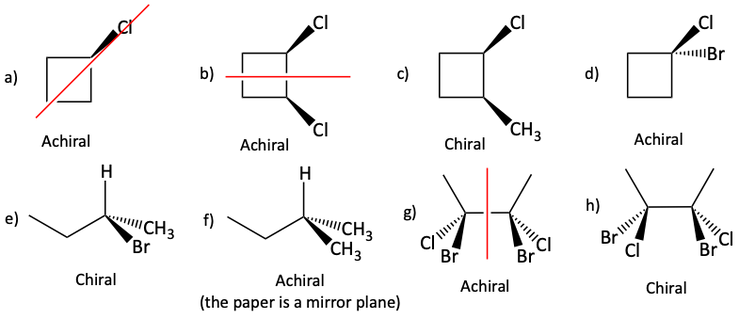Stereochemistry
Introduction
Stereochemistry is the study of 3D structures of molecules. How are the atoms of a molecule arranged in space? This may seem boring, but it is literally a matter of life and death. In the late 1950’s, thalidomide was an over-the-counter drug prescribed to pregnant women in West Germany. This drug helped with nausea associated with morning sickness. It worked well, but soon, nearly 7000 babies were born with birth defects. They had a malformation of their arms and legs. More than half of them died in infancy. Because of this, thalidomide was pulled from the market in the early 1960’s.
Thalidomide is a compound that exists as two different mirror images. One of these mirror images helped fix nausea. The other mirror image caused birth defects. Many times, when a medicine is produced that has two different mirror images, one is bioactive while the other is not. After thalidomide, we now only sell the bioactive enantiomer unless it is proven that the other one does not cause harm. Now, we try to produce only one of the mirror images, or if we produce a mixture of the two, we separate them. Unfortunately, for thalidomide, it would not have mattered if only the good mirror image was sold. In the body, the good thalidomide mirror image gets converted into a mixture of the good and bad.

Thalidomide mirror images
Chirality - handedness
If early some morning you groggily put your right foot into your left shoe, you would be able to tell because your foot would hurt. Why? Your feet are mirror images of each other. Your shoes are mirror images of each other. But, there is a difference between your left and right foot. They are not identical. There is a difference between your left and right shoe. They are not identical. Your feet are chiral. Your shoes are chiral. They have a handedness. Hands and gloves are also chiral. You cannot put your right hand in your left glove. A chiral object has a non-superimposable mirror image. Another way to think about it is it is an object whose mirror image is different or not identical.
Not every object is chiral. Most socks are not. You are equally comfortable if you put a tube sock on either foot. It makes no difference. They do not have handedness. Socks are achiral. Achiral means “not chiral”. It is an object with a mirror image that is identical. The chairs in the picture below are achiral. The two green rocking chairs are mirror images of each other. If you sit in either chair, you could tell no difference. They are identical. Not all chairs are achiral. Some desks with a writing surface are chiral. They are right or left-handed. You can tell the difference if you sit in one or the other.

Chiral

Chiral

Achiral

Chiral
Whenever you are trying to identify if an object is chiral, you compare it to its mirror image. You take the mirror image and can turn it, rotate it, or flip it any way you can. If you can make it look identical to the original object, it is NOT chiral. If you cannot make it look the same and are convinced that the mirror image is different than the original object, it is chiral.
1. Are the following objects chiral or achiral?
a) a pair of scissors
b) a screw
c) a screwdriver
d) a hammer
Molecules can also be chiral or achiral. Let’s look at a carbon atom with different groups on it. This is how we determine if a molecule is chiral or achiral.

The first molecule with four different groups is chiral. The second with only three different types of groups is achiral. A carbon atom with four different groups on it is called an asymmetric carbon atom, stereocenter, or stereogenic center. Some call it a chiral carbon or a chiral center, but the term chiral should really be reserved for entire molecules or objects.
2. The following molecules each have one stereocenter in them. Find the stereocenter (the one with four different groups on it) and circle it. Hint: Remember that hydrogen atoms are not always drawn.

All of the previous compounds with one stereocenter are chiral. This is a big help in helping identify if a compound is chiral or not! A compound is chiral if it has only one stereocenter. If a compound has zero or two stereocenters, we need to look more carefully. These molecules can be either chiral or achiral. Let’s look at how compounds with two stereocenters can be either. The carbon atoms labeled with * are stereocenters.


Achiral molecules with two stereocenters are usually very symmetric. If a mirror plane can be found in the middle of the molecule then it is achiral.

A molecule is achiral if it has a mirror plane in it.

A molecule is usually achiral if it has zero stereocenters. The very few zero stereocenter molecules that are chiral have fan blade type twist in them. For example, the following molecule has zero stereocenters and is chiral.


3. Are the following molecules chiral or achiral?
a)

b)

c)

d)

e)

f)

g)

h)
Answers
1.Are the following objects chiral or achiral?
a) a pair of scissors – Chiral (there are left and right handed scissors)
b) a screw – Chiral (because of the threads)
c) a screwdriver - Achiral
d) a hammer - Achiral
2.

3.

